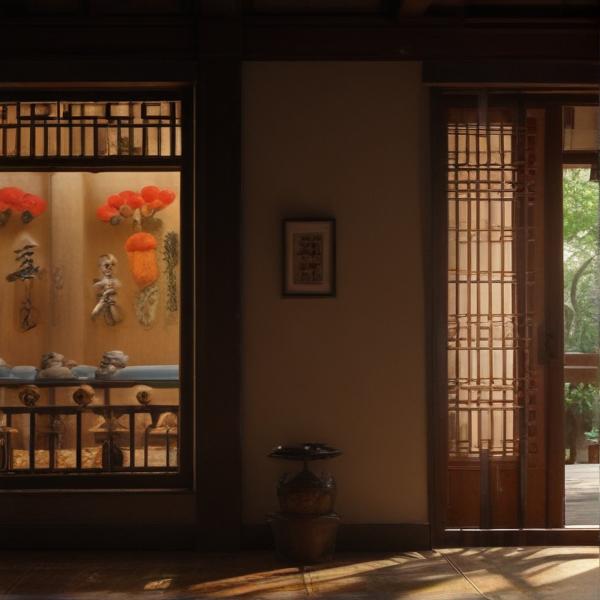基本信息 (Basic Information)
含义与用法 (Meanings & Usage)
中文核心释义 (Core Chinese Meaning): 一种多年生草本植物,常见于湿地,茎叶可用于搭建简易屋顶、制作扫帚等。
英文核心释义 (Core English Meaning): A perennial grass, often found in wetlands; its stems and leaves are used for making simple roofs or brooms.
象形意义 / 为何这么写 (Pictographic Meaning / Writing Rationale)
文言文释义 (Classical Chinese Meaning)
与现代意义相近,常用于指茅草及用茅草盖成的房屋。Similar to modern meaning: often refers to cogon grass and thatched huts in classical texts.
深入学习 (In-depth Study)
字源故事 (Origin Story)
字形演变 (Character Evolution)
常用词语和例句 (Common Words & Examples)
茅草 (cogon grass; thatching grass)
屋顶用茅草铺成,既经济又美观。
Eng: The roof is thatched with cogon grass, which is both economical and attractive.
茅屋 (thatch hut; thatched cottage)
诗人住在一间简陋的茅屋里。
Eng: The poet lived in a simple thatched cottage.
茅台 (Maotai (a famous Chinese liquor brand))
茅台酒是中国著名的白酒之一。
Eng: Maotai liquor is one of the most famous Chinese spirits.
相关成语 (Related Idioms)
茅塞顿开
Meaning: suddenly see the light; a sudden realization
多语言翻译 (核心释义) (Translations (Core Meaning))
- French: herbe à chaume; chaume
- German: Strohdachgras; Schilf
- Spanish: cogón; paja para techos
- Italian: erba da tetto; paglia per tetti
- Portuguese: capim para telhado; sapé
- Russian: ковыль; солома для крыш
- Arabic: عُشْب القش؛ القش لسقوف
- Persian: علف پوشال؛ کاه جهت سقف
- Dutch: strogras; riet voor daken
- Polish: trawa strzechowa; słoma do dachów
- Vietnamese: cỏ tranh; rơm lợp mái
- Ukrainian: трот; солома для дахів
视频学习资源 (Video Learning Resources)
通过以下链接在热门视频网站搜索 "茅" 的更多讲解:
Search for more explanations of "茅" on popular video sites:
- 在 Bilibili.com 搜索 "茅 字源 说文解字" (Search on Bilibili)
- 在 YouTube.com 搜索 "mǎo 茅 character origin etymology" (Search on YouTube)
网络参考 (Web References for "茅") ()
网络内容摘要 (Web Content Summary):
-
核心含义与起源:“茅”指的是一种多年生的草本植物,常用于盖房顶或屋舍,尤其常见于古代简陋房屋,如“茅草屋”。此字源自象形,描绘了草的形状。 Core meaning & origin: "茅" (máo) refers to a perennial grass, often used as thatch for roofs in ancient China, especially for simple houses. The character is pictographic, representing the appearance of grass.
-
文化背景:古人用“琼茅”占卜吉凶,称为“茅卜”。在考古发现中,殷墟出土的古代宫室屋顶皆覆盖以茅草,显示其在建筑和民俗中的重要地位。 Cultural background: In ancient times, "qióng máo" grass was used for divination (called “茅卜”). Archaeological discoveries show that roofs of ancient palaces were often thatched with this grass, highlighting its cultural significance.
-
相关常用词与用法: 常见词有“茅草屋”(thatch-roofed house)、“茅店”(简单旅舍)、“茅塞”(道路被草堵塞)。“茅茨”也常用指用茅草覆盖的屋顶。 Related vocabulary & usage: Common words include “茅草屋” (thatched hut), “茅店” (simple inn), and “茅塞” (blocked by grass). “茅茨” also refers to a thatch roof.
-
易混淆点:“茅”主要指植物或与简陋、质朴相关的事物,易与其它含“草”义的字混淆,如“草”、“芦”。 Possible confusion: “茅” mostly refers to grass or things associated with simplicity or plainness, and may be confused with other plant-related characters like “草” (grass) or “芦” (reed).
本条目信息偏重于建筑、民俗及古代用法。如需现代语境中的更丰富例句或成语,从以上资料来看,信息较为有限。 The information here emphasizes traditional, folk, and architectural contexts. More modern usages or idioms are not well-covered in the available sources.
茅的解释|茅的意思|汉典"茅"字的基本解释 - 漢典
琼茅是一种多年生的草,古人以为灵验,用琼茅来占卜吉凶称为茅卜);茅店(茅草搭盖的客店。指简陋的旅舍);茅茹(茅根相牵连的样子。喻同类事物之相互牵引);茅茨(茅草屋。上古房屋都是茅顶,殷墟出土的宫室屋顶都覆以茅草);茅塞(茅草蔽塞山路,不能通行。
汉字"茅"的起源、演变过程-汉字字源辞典
汉字字源辞典收录13864条汉字词条,基本涵盖了常见汉字的字源解析,是汉字研究的必备工具。 请输入您要查询的汉字: 汉字: 茅: 字源: 茅.
更多图片 (茅 More Images) ()
